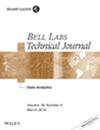下载PDF
{"title":"智能利用多余天线:大规模MIMO、小型蜂窝和TDD","authors":"Jakob Hoydis, Kianoush Hosseini, Stephan ten Brink, Mérouane Debbah","doi":"10.1002/bltj.21602","DOIUrl":null,"url":null,"abstract":"<p>In this paper, we present a vision beyond the conventional Long Term Evolution Fourth Generation (LTE-4G) evolution path and suggest that time division duplexing (TDD) could be a key enabler for a new heterogeneous network architecture with the potential to provide ubiquitous coverage and unprecedented spectral area efficiencies. This architecture is based on a co-channel deployment of macro base stations (BSs) with very large antenna arrays and a secondary tier of small cells (SCs) with a few antennas each. Both tiers employ a TDD protocol in a synchronized fashion. The resulting channel reciprocity enables not only the estimation of large-dimensional channels at the BSs, but also an implicit coordination between both tiers without the need to exchange user data or channel state information (CSI) over the backhaul. In particular, during the uplink (UL), the BSs and SCs can locally estimate the dominant interference sub-space. This knowledge can be leveraged for downlink (DL) precoding to reduce intra- and inter-tier interference. In other words, the BSs and SCs “sacrifice” some of their degrees of freedom for interference rejection. Our simulation results demonstrate that the proposed architecture and precoding scheme can achieve a very attractive rate region compared to several baseline scenarios. For example, with 100 antennas at each BS and four antennas at each SC, we observe an aggregate area throughput of 7.63 Gb/s/km<sup>2</sup> (DL) and 8.93 Gb/s/km<sup>2</sup> (UL) on a 20 MHz band shared by about 100 mobile devices. © 2013 Alcatel-Lucent.</p>","PeriodicalId":55592,"journal":{"name":"Bell Labs Technical Journal","volume":"18 2","pages":"5-21"},"PeriodicalIF":0.0000,"publicationDate":"2013-08-28","publicationTypes":"Journal Article","fieldsOfStudy":null,"isOpenAccess":false,"openAccessPdf":"https://sci-hub-pdf.com/10.1002/bltj.21602","citationCount":"206","resultStr":"{\"title\":\"Making Smart Use of Excess Antennas: Massive MIMO, Small Cells, and TDD\",\"authors\":\"Jakob Hoydis, Kianoush Hosseini, Stephan ten Brink, Mérouane Debbah\",\"doi\":\"10.1002/bltj.21602\",\"DOIUrl\":null,\"url\":null,\"abstract\":\"<p>In this paper, we present a vision beyond the conventional Long Term Evolution Fourth Generation (LTE-4G) evolution path and suggest that time division duplexing (TDD) could be a key enabler for a new heterogeneous network architecture with the potential to provide ubiquitous coverage and unprecedented spectral area efficiencies. This architecture is based on a co-channel deployment of macro base stations (BSs) with very large antenna arrays and a secondary tier of small cells (SCs) with a few antennas each. Both tiers employ a TDD protocol in a synchronized fashion. The resulting channel reciprocity enables not only the estimation of large-dimensional channels at the BSs, but also an implicit coordination between both tiers without the need to exchange user data or channel state information (CSI) over the backhaul. In particular, during the uplink (UL), the BSs and SCs can locally estimate the dominant interference sub-space. This knowledge can be leveraged for downlink (DL) precoding to reduce intra- and inter-tier interference. In other words, the BSs and SCs “sacrifice” some of their degrees of freedom for interference rejection. Our simulation results demonstrate that the proposed architecture and precoding scheme can achieve a very attractive rate region compared to several baseline scenarios. For example, with 100 antennas at each BS and four antennas at each SC, we observe an aggregate area throughput of 7.63 Gb/s/km<sup>2</sup> (DL) and 8.93 Gb/s/km<sup>2</sup> (UL) on a 20 MHz band shared by about 100 mobile devices. © 2013 Alcatel-Lucent.</p>\",\"PeriodicalId\":55592,\"journal\":{\"name\":\"Bell Labs Technical Journal\",\"volume\":\"18 2\",\"pages\":\"5-21\"},\"PeriodicalIF\":0.0000,\"publicationDate\":\"2013-08-28\",\"publicationTypes\":\"Journal Article\",\"fieldsOfStudy\":null,\"isOpenAccess\":false,\"openAccessPdf\":\"https://sci-hub-pdf.com/10.1002/bltj.21602\",\"citationCount\":\"206\",\"resultStr\":null,\"platform\":\"Semanticscholar\",\"paperid\":null,\"PeriodicalName\":\"Bell Labs Technical Journal\",\"FirstCategoryId\":\"1085\",\"ListUrlMain\":\"https://onlinelibrary.wiley.com/doi/10.1002/bltj.21602\",\"RegionNum\":0,\"RegionCategory\":null,\"ArticlePicture\":[],\"TitleCN\":null,\"AbstractTextCN\":null,\"PMCID\":null,\"EPubDate\":\"\",\"PubModel\":\"\",\"JCR\":\"Q1\",\"JCRName\":\"Engineering\",\"Score\":null,\"Total\":0}","platform":"Semanticscholar","paperid":null,"PeriodicalName":"Bell Labs Technical Journal","FirstCategoryId":"1085","ListUrlMain":"https://onlinelibrary.wiley.com/doi/10.1002/bltj.21602","RegionNum":0,"RegionCategory":null,"ArticlePicture":[],"TitleCN":null,"AbstractTextCN":null,"PMCID":null,"EPubDate":"","PubModel":"","JCR":"Q1","JCRName":"Engineering","Score":null,"Total":0}
引用次数: 206
引用
批量引用

 求助内容:
求助内容: 应助结果提醒方式:
应助结果提醒方式:


